Determining Supply Chain Information Transparency and Performance
VerifiedAdded on 2022/12/23
|8
|2118
|62
Report
AI Summary
This report delves into the critical aspects of supply chain transparency and its impact on holistic performance. It begins by defining supply chain transparency and its growing importance, especially with increasing consumer demands. The main body explores qualitative and quantitative measures for assessing transparency, including financial and non-financial metrics, and the bull-whip effect. It then examines five levels of information transparency: branding, strategic, physical-digital, on-site, and consumer-stamped. The report also outlines strategies for enhancing transparency, such as risk prioritization, visualization, and addressing information gaps. Furthermore, it discusses challenges like mapping complexities and gaining stakeholder approval. The report concludes by emphasizing the benefits of applying a transparency approach to business processes and the role of technology in overcoming challenges, supported by relevant references.
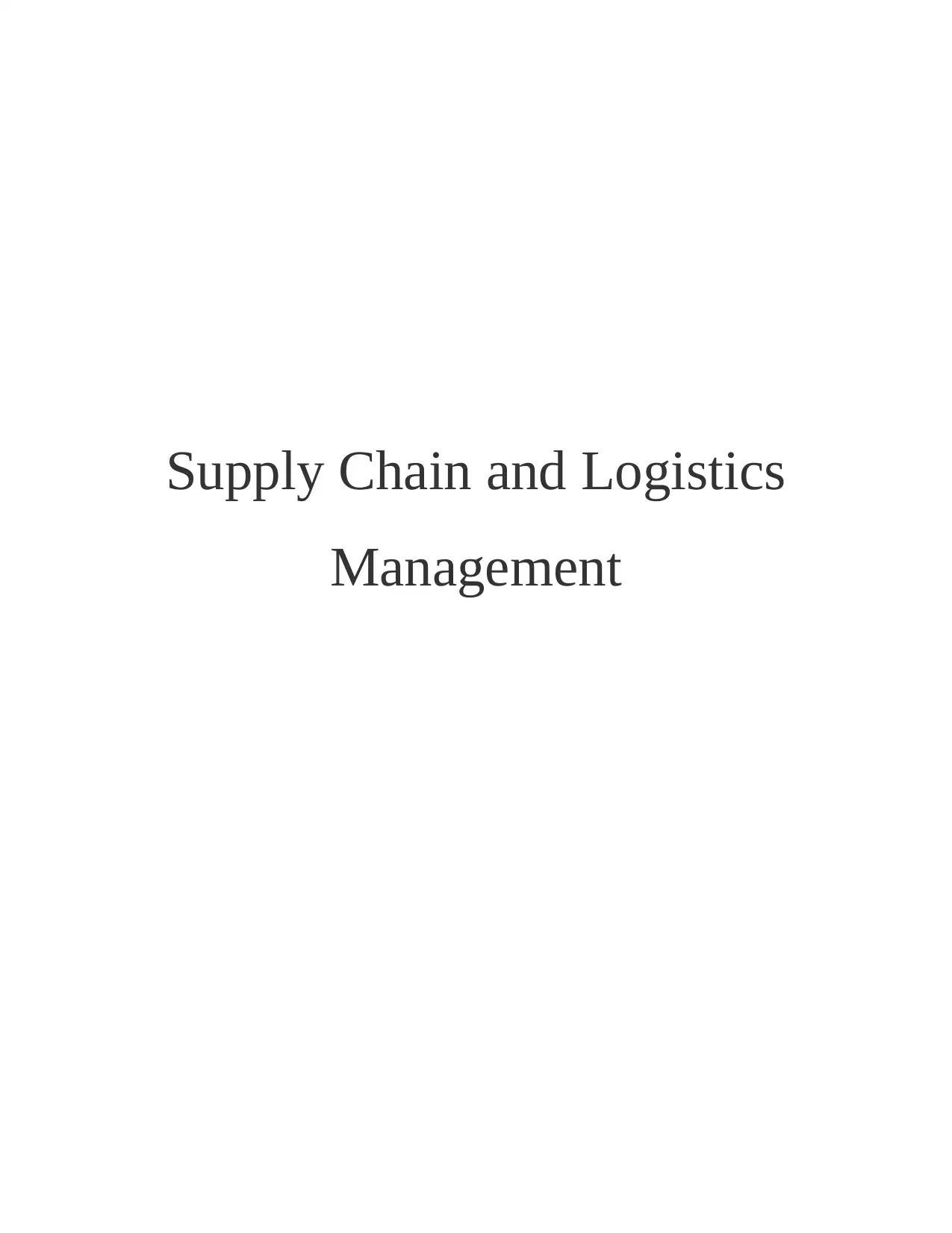
Supply Chain and Logistics
Management
Management
Paraphrase This Document
Need a fresh take? Get an instant paraphrase of this document with our AI Paraphraser
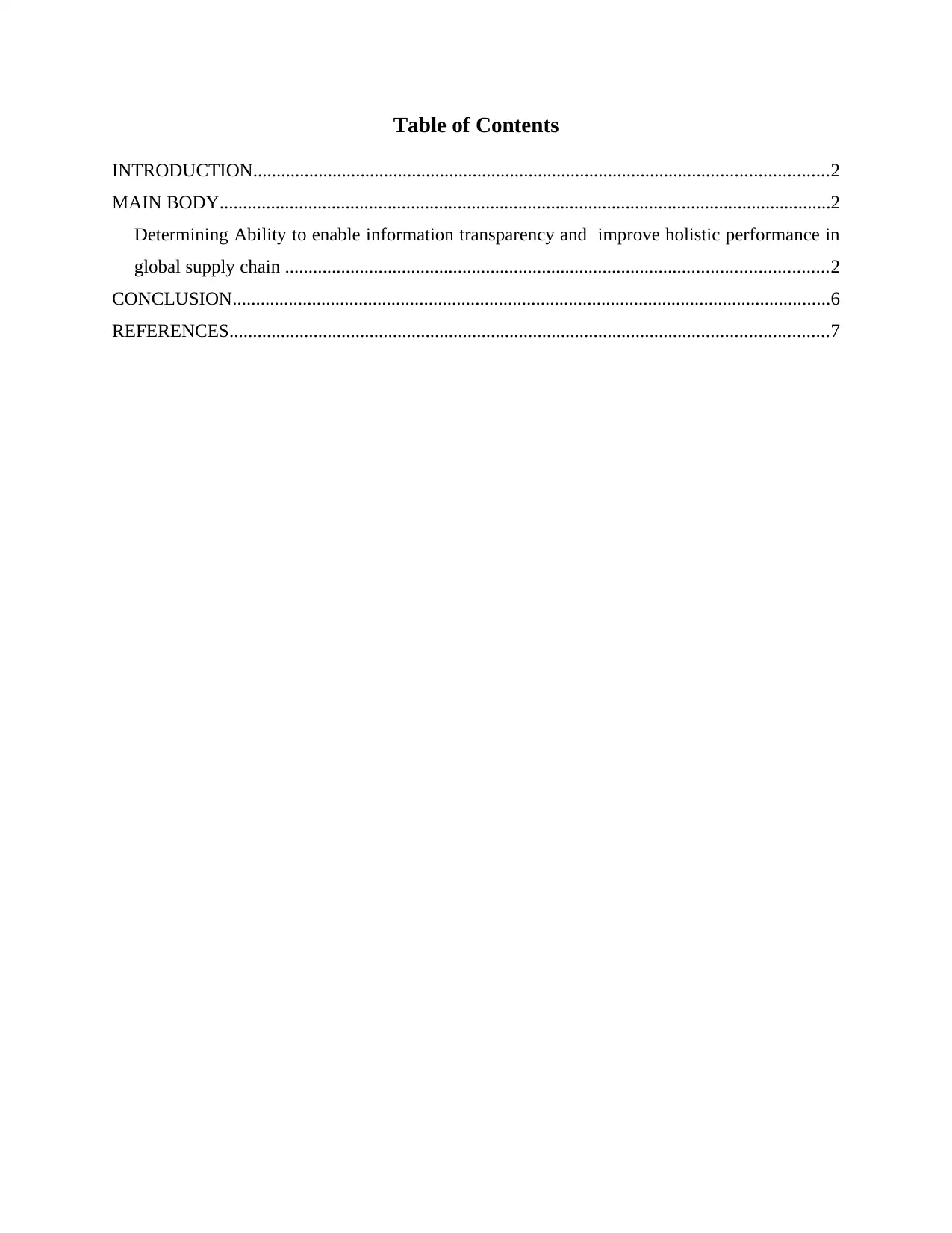
Table of Contents
INTRODUCTION...........................................................................................................................2
MAIN BODY...................................................................................................................................2
Determining Ability to enable information transparency and improve holistic performance in
global supply chain ....................................................................................................................2
CONCLUSION................................................................................................................................6
REFERENCES................................................................................................................................7
INTRODUCTION...........................................................................................................................2
MAIN BODY...................................................................................................................................2
Determining Ability to enable information transparency and improve holistic performance in
global supply chain ....................................................................................................................2
CONCLUSION................................................................................................................................6
REFERENCES................................................................................................................................7
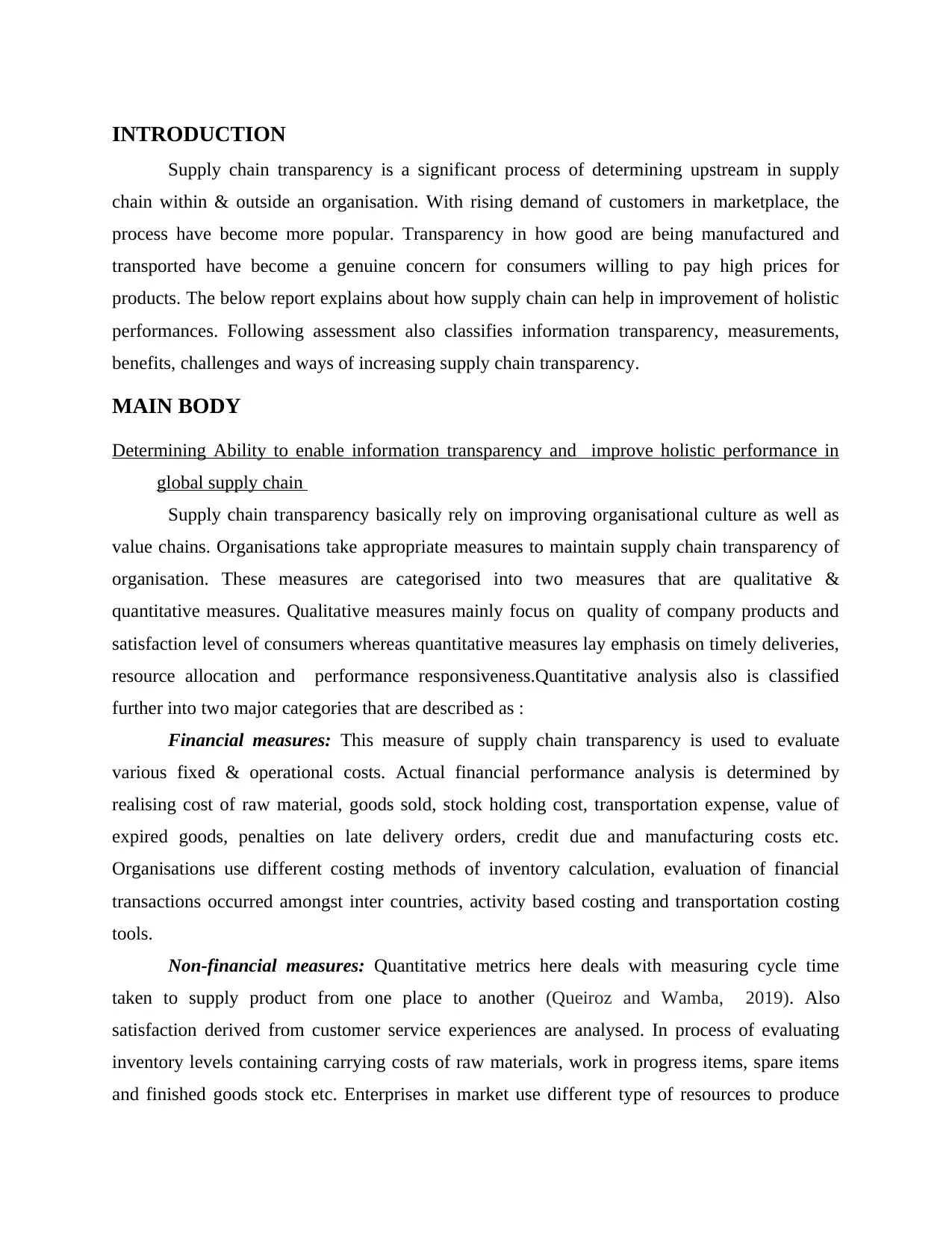
INTRODUCTION
Supply chain transparency is a significant process of determining upstream in supply
chain within & outside an organisation. With rising demand of customers in marketplace, the
process have become more popular. Transparency in how good are being manufactured and
transported have become a genuine concern for consumers willing to pay high prices for
products. The below report explains about how supply chain can help in improvement of holistic
performances. Following assessment also classifies information transparency, measurements,
benefits, challenges and ways of increasing supply chain transparency.
MAIN BODY
Determining Ability to enable information transparency and improve holistic performance in
global supply chain
Supply chain transparency basically rely on improving organisational culture as well as
value chains. Organisations take appropriate measures to maintain supply chain transparency of
organisation. These measures are categorised into two measures that are qualitative &
quantitative measures. Qualitative measures mainly focus on quality of company products and
satisfaction level of consumers whereas quantitative measures lay emphasis on timely deliveries,
resource allocation and performance responsiveness.Quantitative analysis also is classified
further into two major categories that are described as :
Financial measures: This measure of supply chain transparency is used to evaluate
various fixed & operational costs. Actual financial performance analysis is determined by
realising cost of raw material, goods sold, stock holding cost, transportation expense, value of
expired goods, penalties on late delivery orders, credit due and manufacturing costs etc.
Organisations use different costing methods of inventory calculation, evaluation of financial
transactions occurred amongst inter countries, activity based costing and transportation costing
tools.
Non-financial measures: Quantitative metrics here deals with measuring cycle time
taken to supply product from one place to another (Queiroz and Wamba, 2019). Also
satisfaction derived from customer service experiences are analysed. In process of evaluating
inventory levels containing carrying costs of raw materials, work in progress items, spare items
and finished goods stock etc. Enterprises in market use different type of resources to produce
Supply chain transparency is a significant process of determining upstream in supply
chain within & outside an organisation. With rising demand of customers in marketplace, the
process have become more popular. Transparency in how good are being manufactured and
transported have become a genuine concern for consumers willing to pay high prices for
products. The below report explains about how supply chain can help in improvement of holistic
performances. Following assessment also classifies information transparency, measurements,
benefits, challenges and ways of increasing supply chain transparency.
MAIN BODY
Determining Ability to enable information transparency and improve holistic performance in
global supply chain
Supply chain transparency basically rely on improving organisational culture as well as
value chains. Organisations take appropriate measures to maintain supply chain transparency of
organisation. These measures are categorised into two measures that are qualitative &
quantitative measures. Qualitative measures mainly focus on quality of company products and
satisfaction level of consumers whereas quantitative measures lay emphasis on timely deliveries,
resource allocation and performance responsiveness.Quantitative analysis also is classified
further into two major categories that are described as :
Financial measures: This measure of supply chain transparency is used to evaluate
various fixed & operational costs. Actual financial performance analysis is determined by
realising cost of raw material, goods sold, stock holding cost, transportation expense, value of
expired goods, penalties on late delivery orders, credit due and manufacturing costs etc.
Organisations use different costing methods of inventory calculation, evaluation of financial
transactions occurred amongst inter countries, activity based costing and transportation costing
tools.
Non-financial measures: Quantitative metrics here deals with measuring cycle time
taken to supply product from one place to another (Queiroz and Wamba, 2019). Also
satisfaction derived from customer service experiences are analysed. In process of evaluating
inventory levels containing carrying costs of raw materials, work in progress items, spare items
and finished goods stock etc. Enterprises in market use different type of resources to produce
⊘ This is a preview!⊘
Do you want full access?
Subscribe today to unlock all pages.

Trusted by 1+ million students worldwide
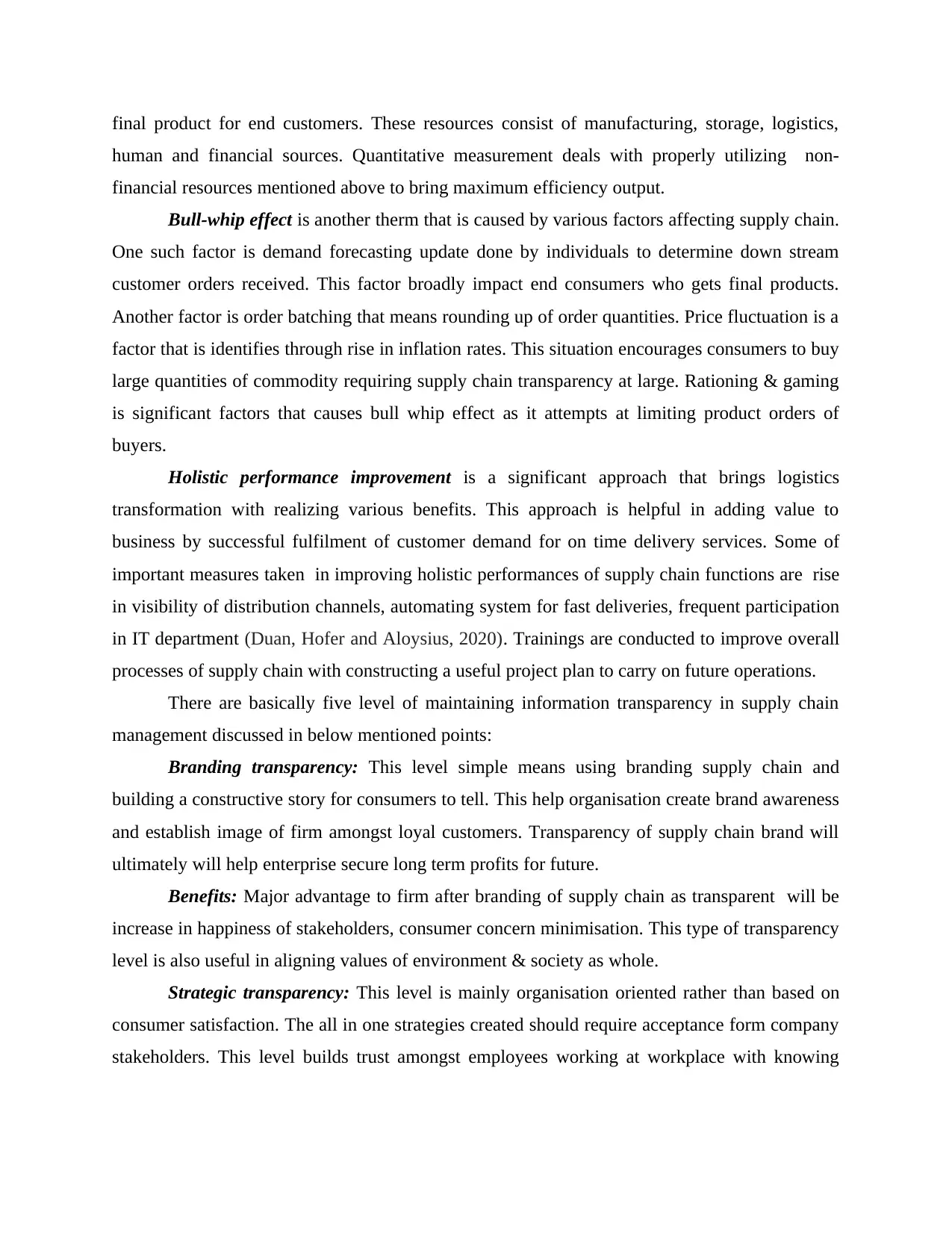
final product for end customers. These resources consist of manufacturing, storage, logistics,
human and financial sources. Quantitative measurement deals with properly utilizing non-
financial resources mentioned above to bring maximum efficiency output.
Bull-whip effect is another therm that is caused by various factors affecting supply chain.
One such factor is demand forecasting update done by individuals to determine down stream
customer orders received. This factor broadly impact end consumers who gets final products.
Another factor is order batching that means rounding up of order quantities. Price fluctuation is a
factor that is identifies through rise in inflation rates. This situation encourages consumers to buy
large quantities of commodity requiring supply chain transparency at large. Rationing & gaming
is significant factors that causes bull whip effect as it attempts at limiting product orders of
buyers.
Holistic performance improvement is a significant approach that brings logistics
transformation with realizing various benefits. This approach is helpful in adding value to
business by successful fulfilment of customer demand for on time delivery services. Some of
important measures taken in improving holistic performances of supply chain functions are rise
in visibility of distribution channels, automating system for fast deliveries, frequent participation
in IT department (Duan, Hofer and Aloysius, 2020). Trainings are conducted to improve overall
processes of supply chain with constructing a useful project plan to carry on future operations.
There are basically five level of maintaining information transparency in supply chain
management discussed in below mentioned points:
Branding transparency: This level simple means using branding supply chain and
building a constructive story for consumers to tell. This help organisation create brand awareness
and establish image of firm amongst loyal customers. Transparency of supply chain brand will
ultimately will help enterprise secure long term profits for future.
Benefits: Major advantage to firm after branding of supply chain as transparent will be
increase in happiness of stakeholders, consumer concern minimisation. This type of transparency
level is also useful in aligning values of environment & society as whole.
Strategic transparency: This level is mainly organisation oriented rather than based on
consumer satisfaction. The all in one strategies created should require acceptance form company
stakeholders. This level builds trust amongst employees working at workplace with knowing
human and financial sources. Quantitative measurement deals with properly utilizing non-
financial resources mentioned above to bring maximum efficiency output.
Bull-whip effect is another therm that is caused by various factors affecting supply chain.
One such factor is demand forecasting update done by individuals to determine down stream
customer orders received. This factor broadly impact end consumers who gets final products.
Another factor is order batching that means rounding up of order quantities. Price fluctuation is a
factor that is identifies through rise in inflation rates. This situation encourages consumers to buy
large quantities of commodity requiring supply chain transparency at large. Rationing & gaming
is significant factors that causes bull whip effect as it attempts at limiting product orders of
buyers.
Holistic performance improvement is a significant approach that brings logistics
transformation with realizing various benefits. This approach is helpful in adding value to
business by successful fulfilment of customer demand for on time delivery services. Some of
important measures taken in improving holistic performances of supply chain functions are rise
in visibility of distribution channels, automating system for fast deliveries, frequent participation
in IT department (Duan, Hofer and Aloysius, 2020). Trainings are conducted to improve overall
processes of supply chain with constructing a useful project plan to carry on future operations.
There are basically five level of maintaining information transparency in supply chain
management discussed in below mentioned points:
Branding transparency: This level simple means using branding supply chain and
building a constructive story for consumers to tell. This help organisation create brand awareness
and establish image of firm amongst loyal customers. Transparency of supply chain brand will
ultimately will help enterprise secure long term profits for future.
Benefits: Major advantage to firm after branding of supply chain as transparent will be
increase in happiness of stakeholders, consumer concern minimisation. This type of transparency
level is also useful in aligning values of environment & society as whole.
Strategic transparency: This level is mainly organisation oriented rather than based on
consumer satisfaction. The all in one strategies created should require acceptance form company
stakeholders. This level builds trust amongst employees working at workplace with knowing
Paraphrase This Document
Need a fresh take? Get an instant paraphrase of this document with our AI Paraphraser
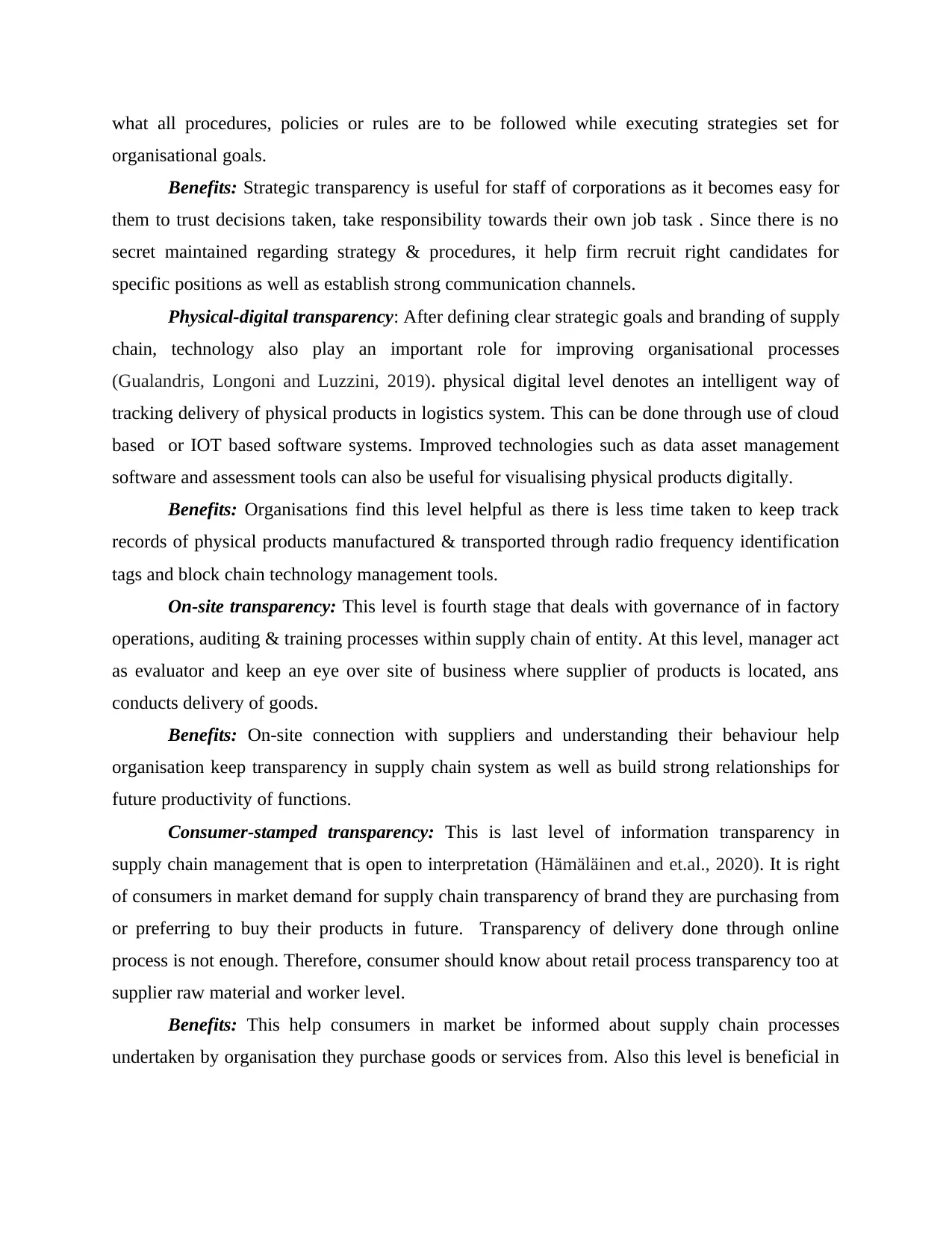
what all procedures, policies or rules are to be followed while executing strategies set for
organisational goals.
Benefits: Strategic transparency is useful for staff of corporations as it becomes easy for
them to trust decisions taken, take responsibility towards their own job task . Since there is no
secret maintained regarding strategy & procedures, it help firm recruit right candidates for
specific positions as well as establish strong communication channels.
Physical-digital transparency: After defining clear strategic goals and branding of supply
chain, technology also play an important role for improving organisational processes
(Gualandris, Longoni and Luzzini, 2019). physical digital level denotes an intelligent way of
tracking delivery of physical products in logistics system. This can be done through use of cloud
based or IOT based software systems. Improved technologies such as data asset management
software and assessment tools can also be useful for visualising physical products digitally.
Benefits: Organisations find this level helpful as there is less time taken to keep track
records of physical products manufactured & transported through radio frequency identification
tags and block chain technology management tools.
On-site transparency: This level is fourth stage that deals with governance of in factory
operations, auditing & training processes within supply chain of entity. At this level, manager act
as evaluator and keep an eye over site of business where supplier of products is located, ans
conducts delivery of goods.
Benefits: On-site connection with suppliers and understanding their behaviour help
organisation keep transparency in supply chain system as well as build strong relationships for
future productivity of functions.
Consumer-stamped transparency: This is last level of information transparency in
supply chain management that is open to interpretation (Hämäläinen and et.al., 2020). It is right
of consumers in market demand for supply chain transparency of brand they are purchasing from
or preferring to buy their products in future. Transparency of delivery done through online
process is not enough. Therefore, consumer should know about retail process transparency too at
supplier raw material and worker level.
Benefits: This help consumers in market be informed about supply chain processes
undertaken by organisation they purchase goods or services from. Also this level is beneficial in
organisational goals.
Benefits: Strategic transparency is useful for staff of corporations as it becomes easy for
them to trust decisions taken, take responsibility towards their own job task . Since there is no
secret maintained regarding strategy & procedures, it help firm recruit right candidates for
specific positions as well as establish strong communication channels.
Physical-digital transparency: After defining clear strategic goals and branding of supply
chain, technology also play an important role for improving organisational processes
(Gualandris, Longoni and Luzzini, 2019). physical digital level denotes an intelligent way of
tracking delivery of physical products in logistics system. This can be done through use of cloud
based or IOT based software systems. Improved technologies such as data asset management
software and assessment tools can also be useful for visualising physical products digitally.
Benefits: Organisations find this level helpful as there is less time taken to keep track
records of physical products manufactured & transported through radio frequency identification
tags and block chain technology management tools.
On-site transparency: This level is fourth stage that deals with governance of in factory
operations, auditing & training processes within supply chain of entity. At this level, manager act
as evaluator and keep an eye over site of business where supplier of products is located, ans
conducts delivery of goods.
Benefits: On-site connection with suppliers and understanding their behaviour help
organisation keep transparency in supply chain system as well as build strong relationships for
future productivity of functions.
Consumer-stamped transparency: This is last level of information transparency in
supply chain management that is open to interpretation (Hämäläinen and et.al., 2020). It is right
of consumers in market demand for supply chain transparency of brand they are purchasing from
or preferring to buy their products in future. Transparency of delivery done through online
process is not enough. Therefore, consumer should know about retail process transparency too at
supplier raw material and worker level.
Benefits: This help consumers in market be informed about supply chain processes
undertaken by organisation they purchase goods or services from. Also this level is beneficial in
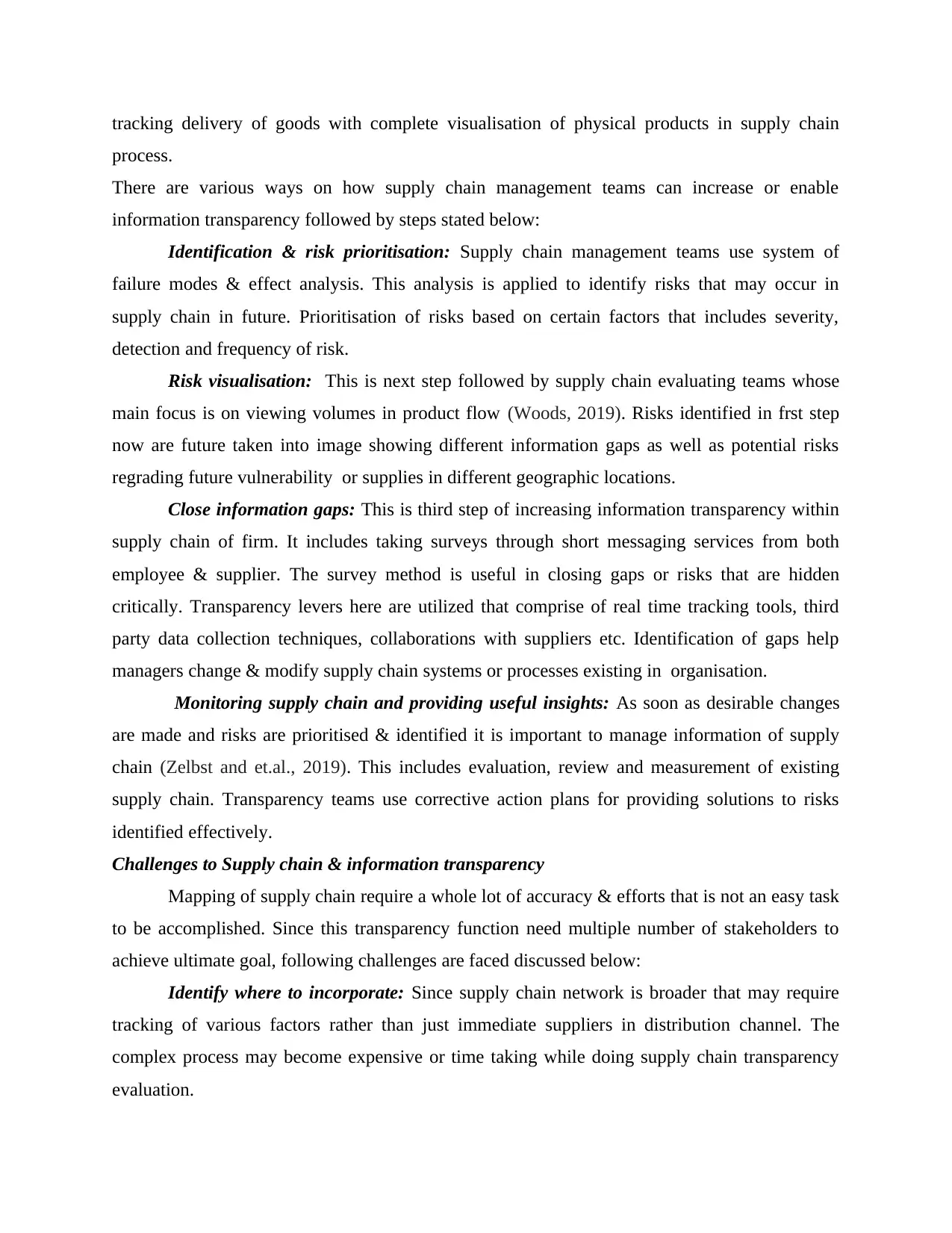
tracking delivery of goods with complete visualisation of physical products in supply chain
process.
There are various ways on how supply chain management teams can increase or enable
information transparency followed by steps stated below:
Identification & risk prioritisation: Supply chain management teams use system of
failure modes & effect analysis. This analysis is applied to identify risks that may occur in
supply chain in future. Prioritisation of risks based on certain factors that includes severity,
detection and frequency of risk.
Risk visualisation: This is next step followed by supply chain evaluating teams whose
main focus is on viewing volumes in product flow (Woods, 2019). Risks identified in frst step
now are future taken into image showing different information gaps as well as potential risks
regrading future vulnerability or supplies in different geographic locations.
Close information gaps: This is third step of increasing information transparency within
supply chain of firm. It includes taking surveys through short messaging services from both
employee & supplier. The survey method is useful in closing gaps or risks that are hidden
critically. Transparency levers here are utilized that comprise of real time tracking tools, third
party data collection techniques, collaborations with suppliers etc. Identification of gaps help
managers change & modify supply chain systems or processes existing in organisation.
Monitoring supply chain and providing useful insights: As soon as desirable changes
are made and risks are prioritised & identified it is important to manage information of supply
chain (Zelbst and et.al., 2019). This includes evaluation, review and measurement of existing
supply chain. Transparency teams use corrective action plans for providing solutions to risks
identified effectively.
Challenges to Supply chain & information transparency
Mapping of supply chain require a whole lot of accuracy & efforts that is not an easy task
to be accomplished. Since this transparency function need multiple number of stakeholders to
achieve ultimate goal, following challenges are faced discussed below:
Identify where to incorporate: Since supply chain network is broader that may require
tracking of various factors rather than just immediate suppliers in distribution channel. The
complex process may become expensive or time taking while doing supply chain transparency
evaluation.
process.
There are various ways on how supply chain management teams can increase or enable
information transparency followed by steps stated below:
Identification & risk prioritisation: Supply chain management teams use system of
failure modes & effect analysis. This analysis is applied to identify risks that may occur in
supply chain in future. Prioritisation of risks based on certain factors that includes severity,
detection and frequency of risk.
Risk visualisation: This is next step followed by supply chain evaluating teams whose
main focus is on viewing volumes in product flow (Woods, 2019). Risks identified in frst step
now are future taken into image showing different information gaps as well as potential risks
regrading future vulnerability or supplies in different geographic locations.
Close information gaps: This is third step of increasing information transparency within
supply chain of firm. It includes taking surveys through short messaging services from both
employee & supplier. The survey method is useful in closing gaps or risks that are hidden
critically. Transparency levers here are utilized that comprise of real time tracking tools, third
party data collection techniques, collaborations with suppliers etc. Identification of gaps help
managers change & modify supply chain systems or processes existing in organisation.
Monitoring supply chain and providing useful insights: As soon as desirable changes
are made and risks are prioritised & identified it is important to manage information of supply
chain (Zelbst and et.al., 2019). This includes evaluation, review and measurement of existing
supply chain. Transparency teams use corrective action plans for providing solutions to risks
identified effectively.
Challenges to Supply chain & information transparency
Mapping of supply chain require a whole lot of accuracy & efforts that is not an easy task
to be accomplished. Since this transparency function need multiple number of stakeholders to
achieve ultimate goal, following challenges are faced discussed below:
Identify where to incorporate: Since supply chain network is broader that may require
tracking of various factors rather than just immediate suppliers in distribution channel. The
complex process may become expensive or time taking while doing supply chain transparency
evaluation.
⊘ This is a preview!⊘
Do you want full access?
Subscribe today to unlock all pages.

Trusted by 1+ million students worldwide
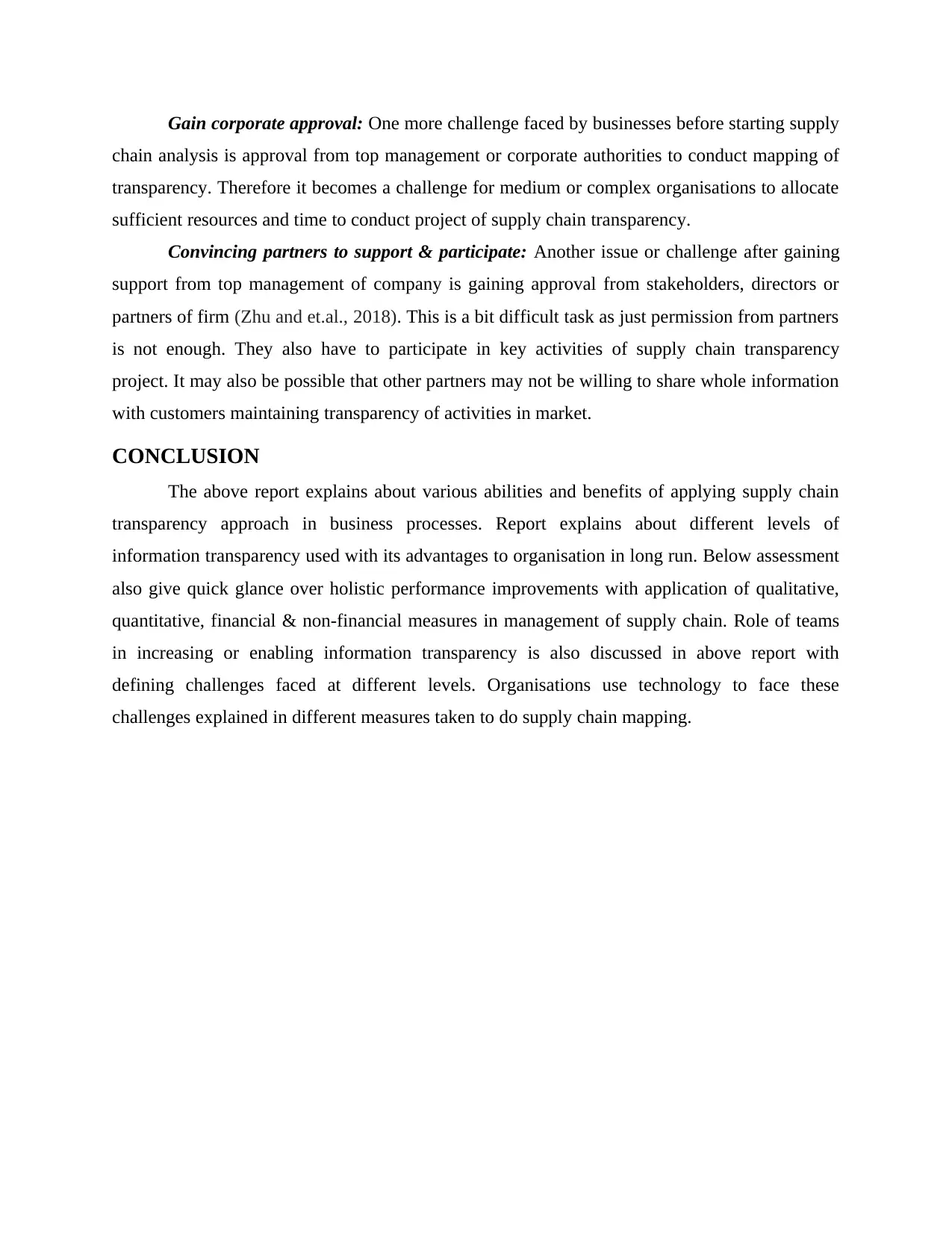
Gain corporate approval: One more challenge faced by businesses before starting supply
chain analysis is approval from top management or corporate authorities to conduct mapping of
transparency. Therefore it becomes a challenge for medium or complex organisations to allocate
sufficient resources and time to conduct project of supply chain transparency.
Convincing partners to support & participate: Another issue or challenge after gaining
support from top management of company is gaining approval from stakeholders, directors or
partners of firm (Zhu and et.al., 2018). This is a bit difficult task as just permission from partners
is not enough. They also have to participate in key activities of supply chain transparency
project. It may also be possible that other partners may not be willing to share whole information
with customers maintaining transparency of activities in market.
CONCLUSION
The above report explains about various abilities and benefits of applying supply chain
transparency approach in business processes. Report explains about different levels of
information transparency used with its advantages to organisation in long run. Below assessment
also give quick glance over holistic performance improvements with application of qualitative,
quantitative, financial & non-financial measures in management of supply chain. Role of teams
in increasing or enabling information transparency is also discussed in above report with
defining challenges faced at different levels. Organisations use technology to face these
challenges explained in different measures taken to do supply chain mapping.
chain analysis is approval from top management or corporate authorities to conduct mapping of
transparency. Therefore it becomes a challenge for medium or complex organisations to allocate
sufficient resources and time to conduct project of supply chain transparency.
Convincing partners to support & participate: Another issue or challenge after gaining
support from top management of company is gaining approval from stakeholders, directors or
partners of firm (Zhu and et.al., 2018). This is a bit difficult task as just permission from partners
is not enough. They also have to participate in key activities of supply chain transparency
project. It may also be possible that other partners may not be willing to share whole information
with customers maintaining transparency of activities in market.
CONCLUSION
The above report explains about various abilities and benefits of applying supply chain
transparency approach in business processes. Report explains about different levels of
information transparency used with its advantages to organisation in long run. Below assessment
also give quick glance over holistic performance improvements with application of qualitative,
quantitative, financial & non-financial measures in management of supply chain. Role of teams
in increasing or enabling information transparency is also discussed in above report with
defining challenges faced at different levels. Organisations use technology to face these
challenges explained in different measures taken to do supply chain mapping.
Paraphrase This Document
Need a fresh take? Get an instant paraphrase of this document with our AI Paraphraser
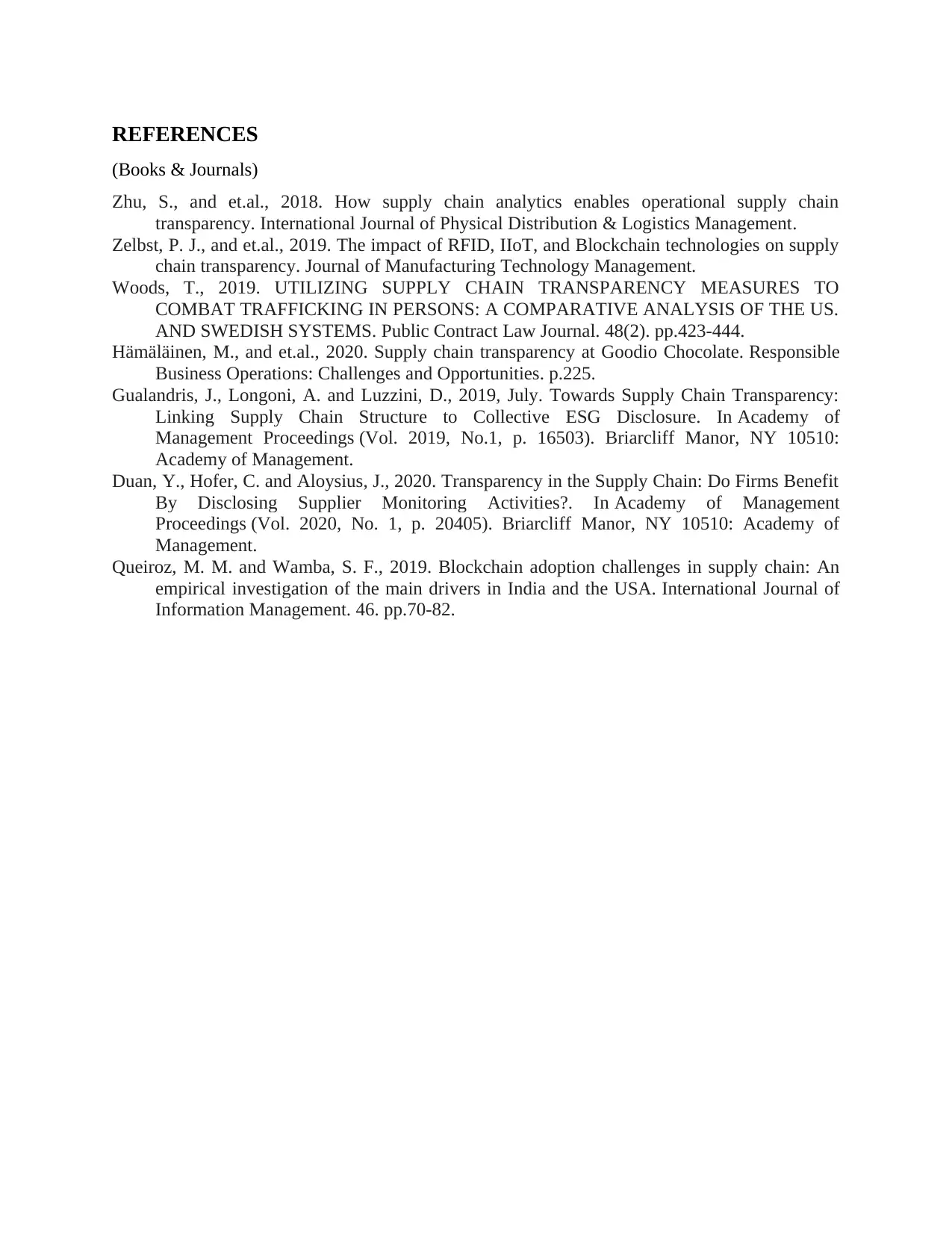
REFERENCES
(Books & Journals)
Zhu, S., and et.al., 2018. How supply chain analytics enables operational supply chain
transparency. International Journal of Physical Distribution & Logistics Management.
Zelbst, P. J., and et.al., 2019. The impact of RFID, IIoT, and Blockchain technologies on supply
chain transparency. Journal of Manufacturing Technology Management.
Woods, T., 2019. UTILIZING SUPPLY CHAIN TRANSPARENCY MEASURES TO
COMBAT TRAFFICKING IN PERSONS: A COMPARATIVE ANALYSIS OF THE US.
AND SWEDISH SYSTEMS. Public Contract Law Journal. 48(2). pp.423-444.
Hämäläinen, M., and et.al., 2020. Supply chain transparency at Goodio Chocolate. Responsible
Business Operations: Challenges and Opportunities. p.225.
Gualandris, J., Longoni, A. and Luzzini, D., 2019, July. Towards Supply Chain Transparency:
Linking Supply Chain Structure to Collective ESG Disclosure. In Academy of
Management Proceedings (Vol. 2019, No.1, p. 16503). Briarcliff Manor, NY 10510:
Academy of Management.
Duan, Y., Hofer, C. and Aloysius, J., 2020. Transparency in the Supply Chain: Do Firms Benefit
By Disclosing Supplier Monitoring Activities?. In Academy of Management
Proceedings (Vol. 2020, No. 1, p. 20405). Briarcliff Manor, NY 10510: Academy of
Management.
Queiroz, M. M. and Wamba, S. F., 2019. Blockchain adoption challenges in supply chain: An
empirical investigation of the main drivers in India and the USA. International Journal of
Information Management. 46. pp.70-82.
(Books & Journals)
Zhu, S., and et.al., 2018. How supply chain analytics enables operational supply chain
transparency. International Journal of Physical Distribution & Logistics Management.
Zelbst, P. J., and et.al., 2019. The impact of RFID, IIoT, and Blockchain technologies on supply
chain transparency. Journal of Manufacturing Technology Management.
Woods, T., 2019. UTILIZING SUPPLY CHAIN TRANSPARENCY MEASURES TO
COMBAT TRAFFICKING IN PERSONS: A COMPARATIVE ANALYSIS OF THE US.
AND SWEDISH SYSTEMS. Public Contract Law Journal. 48(2). pp.423-444.
Hämäläinen, M., and et.al., 2020. Supply chain transparency at Goodio Chocolate. Responsible
Business Operations: Challenges and Opportunities. p.225.
Gualandris, J., Longoni, A. and Luzzini, D., 2019, July. Towards Supply Chain Transparency:
Linking Supply Chain Structure to Collective ESG Disclosure. In Academy of
Management Proceedings (Vol. 2019, No.1, p. 16503). Briarcliff Manor, NY 10510:
Academy of Management.
Duan, Y., Hofer, C. and Aloysius, J., 2020. Transparency in the Supply Chain: Do Firms Benefit
By Disclosing Supplier Monitoring Activities?. In Academy of Management
Proceedings (Vol. 2020, No. 1, p. 20405). Briarcliff Manor, NY 10510: Academy of
Management.
Queiroz, M. M. and Wamba, S. F., 2019. Blockchain adoption challenges in supply chain: An
empirical investigation of the main drivers in India and the USA. International Journal of
Information Management. 46. pp.70-82.
1 out of 8
Related Documents
Your All-in-One AI-Powered Toolkit for Academic Success.
+13062052269
info@desklib.com
Available 24*7 on WhatsApp / Email
![[object Object]](/_next/static/media/star-bottom.7253800d.svg)
Unlock your academic potential
Copyright © 2020–2025 A2Z Services. All Rights Reserved. Developed and managed by ZUCOL.




